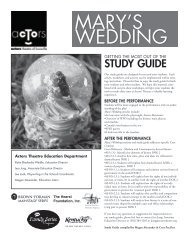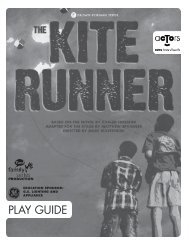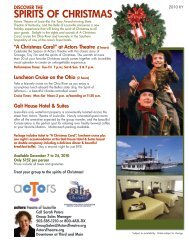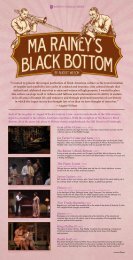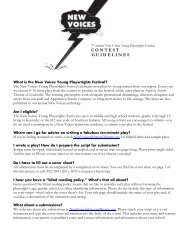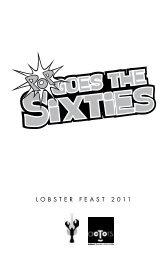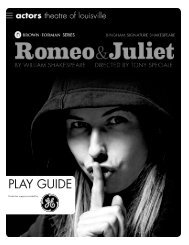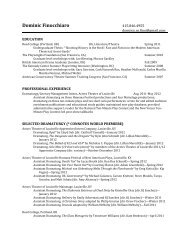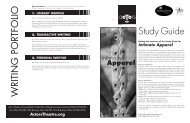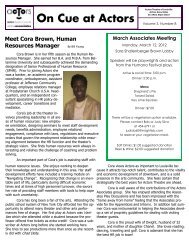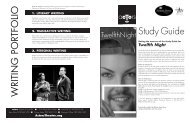A Christmas Carol Play Guide - Actors Theatre of Louisville
A Christmas Carol Play Guide - Actors Theatre of Louisville
A Christmas Carol Play Guide - Actors Theatre of Louisville
- No tags were found...
You also want an ePaper? Increase the reach of your titles
YUMPU automatically turns print PDFs into web optimized ePapers that Google loves.
About theA <strong>Christmas</strong>carol PLAY GUIDEThis play guide is a resource designed toenhance your theatre experience. Its goalis tw<strong>of</strong>old: to nurture the teaching andlearning <strong>of</strong> theatre arts and to encourageessential questions that lead to enduringunderstandings <strong>of</strong> the play’s meaning andrelevance. Inside you will find:• Contextual and historical informationincluding a list <strong>of</strong> characters, plotsynopsis and information about theplaywright.• Evocative, thought provoking articleson topics surrounding the play, which aremeant to incite conversation and analysis.• Bridgework activitiesconnecting themes and ideas from theplay to your curriculum.• Oral discussion and writing promptsencouraging your students to drawconnections between the play and theirown lives. These prompts can easily beadapted to fit most writing objectives.Table <strong>of</strong> contents3 A <strong>Christmas</strong> <strong>Carol</strong> Synopsis, Characters, Setting4 About the Author: Charles Dickens5 <strong>Carol</strong> in Context: The Industrial Revolution6 How <strong>Carol</strong> Changed <strong>Christmas</strong>7 Conducting the <strong>Carol</strong>: An Interview with David Keeton8 How <strong>Carol</strong> Echoes Beyond Victorian England9 What a Scrooge!10 Discussion Questions, Bridgework11 Writing Portfolio12 Other Reading and Works CitedWe encourage you to adapt and extendthe material in any way that bestfits the needs <strong>of</strong> your community <strong>of</strong>learners. Please feel free to make copies<strong>of</strong> this guide, or you may download itfrom our website: <strong>Actors</strong><strong>Theatre</strong>.org/education_guides.htm. We hope thismaterial, combined with our pre-showworkshop, will give you the tools tomake your time at <strong>Actors</strong> <strong>Theatre</strong> avaluable learning experience.A <strong>Christmas</strong> <strong>Carol</strong> student matineesand study guides address specificeduCAtional objectives:<strong>Actors</strong> <strong>Theatre</strong> EducationSteven Rahe, Director <strong>of</strong> EducationJacob Stoebel, Associate Director <strong>of</strong> EducationJulie Mercurio, Education FellowJane B. Jones, Education Intern/Teaching ArtistChristina Lepri, Education Intern/Teaching ArtistLiz Fentress, Teaching ArtistJessica Leader, Teaching ArtistKeith McGill, Teaching ArtistStudy guide compiled by Alex Connolly, Tara Duffy,Adrien-Alice Hansel, Julie McCormick, Steven Rahe,Jacob Stoebel, Amy Wegener.Cover photo by Alan Simons.Graphic design by Elissa Shortridge.• Students will identify or describe theuse <strong>of</strong> elements <strong>of</strong> drama in dramaticworks.2• Students will identify or explain howdrama/theatre fulfills a variety <strong>of</strong>purposes.• Students will identify a variety <strong>of</strong>creative dramatics.The Kentucky Arts Council, thestate arts agency, supports <strong>Actors</strong><strong>Theatre</strong> <strong>of</strong> <strong>Louisville</strong> with state taxdollars and federal funding from theNational Endowment for the Arts.The Crawford Charitable Foundationsupports <strong>Actors</strong> <strong>Theatre</strong> <strong>of</strong> <strong>Louisville</strong>’s 2010-2011 education programs.
Scrooge and others in the 2009 production at <strong>Actors</strong> <strong>Theatre</strong>. Photo by Alan Simons.SynopsisEbenezer Scrooge is a mean, oldbusinessman who thinks that <strong>Christmas</strong>is a frivolous holiday, just an excusefor people not to work. Despite hisvast fortune, Scrooge hoards money,refusing to give to charity because hebelieves that the poor are just lazy anddeserve no such help. He doesn’t evenpay his hardworking and loyal clerk,Bob Cratchit, a fair wage that wouldallow him to get his sick son, TinyTim, proper medical attention! DespiteScrooge’s heartlessness, his nephew andonly living relative, Fred, still wants tospend <strong>Christmas</strong> with his uncle, butthe miser rejects him. On <strong>Christmas</strong>Eve, he is visited by the ghost <strong>of</strong> hisformer business partner, Jacob Marley,who is now paying dearly for how helived his life—the same way Scrooge isliving his life now! Marley tells him thatthree spirits—the Ghosts <strong>of</strong> <strong>Christmas</strong>Past, Present, and Yet to Come—willvisit him that night. These phantomswill show old Scrooge how he becameso hard-hearted, what he’s lost out onbecause <strong>of</strong> it, and what will happen if hekeeps going down this path.- Tara DuffyCast <strong>of</strong>CharactersEbenezer Scrooge— A wealthybut miserly businessman who has nosympathy for the poor nor any <strong>Christmas</strong>cheer. He is transformed when visited bythree ghosts on <strong>Christmas</strong> Eve.Tiny Tim—Bob Cratchit’s youngestson, who is very sick but remains merry andgrateful during the holiday.Bob Cratchit— Scrooge’soverworked and underpaid clerk who isstruggling to support his wife and sixchildren but remains loyal to his cruel boss.Jacob Marley— Scrooge’s businesspartner who died seven years ago. His ghostwalks the earth in chains as a punishmentfor the cruel and greedy way he lived.Ghost <strong>of</strong> <strong>Christmas</strong> Past—This spirit shows Scrooge the events in hispast that have made him into the man heis today.GhoST <strong>of</strong> ChriSTmasPrESEnt— This spirit shows Scroogewhat he has ignored or cut himself <strong>of</strong>f fromin the present.GhoST <strong>of</strong> ChriSTmasyET to Come – This spirit showsScrooge the likely consequences <strong>of</strong> hischoices.Fan—Scrooge’s kind-hearted sisterwho cared about her brother but diedyoung.Fred—Scrooge’s nephew and onlyliving relative. Like his mother, Fan, heis a cheerful person, and wants to spend<strong>Christmas</strong> with his uncle.Fezziwig—The owner <strong>of</strong> thewarehouse business where Scrooge wasan apprentice as a young man, this jollyman threw lively <strong>Christmas</strong> parties yearsago and was a kind employer to Scrooge.Belle—Young Scrooge’s fiancée who isalienated by his obsession with money.SeTTingPlace London, from the slums tomiddle-class homes to wealthy mansions.TIME The Victorian era.3
About the Author: Charles DickensRead more about how the British novelistderived much <strong>of</strong> the inspiration for the settingand characters <strong>of</strong> A <strong>Christmas</strong> <strong>Carol</strong> from hisown life.Charles Dickens (1812-1870) was no stranger to the kind <strong>of</strong>poverty that is graphically depicted in A <strong>Christmas</strong> <strong>Carol</strong>. Born inPortsmouth—a city on England’s south coast—in 1812, Dickensenjoyed a comfortable childhood typical <strong>of</strong> an English middleclassfamily <strong>of</strong> the era. John Dickens, his father, worked as aclerk for the Navy Pay Office, allowing Charles to go to privateschool for a few years. He spent much <strong>of</strong> his free time readingnovels like Robinson Crusoe and Tom Jones, which taught himto carefully observe the people and events surrounding him. Sowhen his father, unable to pay all the family’s bills, ended up indebtor’s prison, the seriousness <strong>of</strong> the event was not lost on thetwelve year old Charles. His father wouldn’t be released from thejail until the debt was paid, so as the oldest son, Charles beganworking ten-hour days at a shoe polish factory, pasting labels tocontainers. Dickens described the factory as “a crazy, tumbledownold house… literally overrun with rats.” The stories he laterwrote sought to enlighten readers about the conditions in whichthe poor had to live and work.By a stroke <strong>of</strong> luck, John Dickens received an inheritance andpaid his debt to get out <strong>of</strong> prison. Charles returned to school butit wasn’t long before the family’s shaky finances forced him backto work, this time as a junior clerk at a law firm. In his spare timehe learned a type <strong>of</strong> shorthand used by journalists, and left thelaw <strong>of</strong>fices in order to become a freelance reporter. His time as ajournalist further exposed Dickens to the disparity between theclasses, an issue that would frequently appear in his novels.A portrait <strong>of</strong> the youngCharles DickensDickens eventually became the editor <strong>of</strong> a literary magazine andpublished many <strong>of</strong> his novels in monthly installments. He wouldlater compile all the sections and publish a book. This format—known as serialization—is like modern television storytelling,where every week the audience finds out a little more about thelarger story.Dickens was one <strong>of</strong> the most popular writers <strong>of</strong> the 19th century,both in his native England and abroad. His other famous worksinclude Oliver Twist, David Copperfield, A Tale <strong>of</strong> Two Cities andGreat Expectations. He visited America twice—the first time wasin 1842, just before the publication <strong>of</strong> A <strong>Christmas</strong> <strong>Carol</strong>. In thetravelogue he published, American Notes for General Circulation,he criticized the sanitary conditions in American cities, provingthat urban blight seen in his novels was not just confined toLondon.During his second visit to America in November 1867 Dickensbecame ill, possibly suffering from a stroke. He returned home togive farewell readings from his most beloved stories for the nexttwo years, as his health continued to worsen. Dickens died in1870 at age 58.-Tara DuffyAn artist’s depiction <strong>of</strong>Dickens’ childhood work4
A CHRISTMAS CARol in Context:The Industrial RevolutionCharles Dickens wrote A<strong>Christmas</strong> <strong>Carol</strong> duringthe Industrial Revolution, aperiod marked by the rapiddevelopment <strong>of</strong> industrythat took place in Englandin the late 18th and early19th centuries.New machines, power sources, andmethods <strong>of</strong> production led to the creation<strong>of</strong> urban industrial centers and a wholenew way <strong>of</strong> life. New machines such as thespinning jenny and power loom producedcloth in a fraction <strong>of</strong> the time it took tomake it by hand. The Industrial Revolutionalso led to a shift in the methods <strong>of</strong>production. Instead <strong>of</strong> highly skilledcraftsmen working on a product from startto finish, factories started dividing thework up into smaller tasks that would becompleted by many people on an assemblyline. In the past, one person might havetaken weeks to make a shirt—spinning thecotton into thread, weaving it on a loom,cutting it, and then sewing it by hand.Think about how much work that wouldbe! With the help <strong>of</strong> assembly lines andnew machines, however, a large team <strong>of</strong>unskilled laborers could make dozens oreven hundreds <strong>of</strong> shirts in one day. Thislowered the cost <strong>of</strong> everyday items andmeant that people could use their time forother things, like education or leisure.These new developments encouragedurbanization. By 1850, more than half <strong>of</strong>the population lived in cities and workedin industry. Britain was becoming therichest country in the world, though withthis great wealth came a widening in thegap between the social classes. The richbecame richer, while the working classeswere left behind. Children as young as fivewere commonly put to work to help supporttheir families, <strong>of</strong>ten in very dangerousfactory jobs. At the time that Dickens waswriting A <strong>Christmas</strong> <strong>Carol</strong>, though newlaws were just beginning to protect workers,conditions were still very inhumane.A <strong>Christmas</strong> <strong>Carol</strong> also draws on some <strong>of</strong>Dickens’ own life experiences. We see thesame desperate circumstances that Dickenssaw in the shoe polish factory when Scroogevisits the slums with the ghost <strong>of</strong> <strong>Christmas</strong>Future, or when he sees the Cratchit familywith the Ghost <strong>of</strong> <strong>Christmas</strong> Present. LikeCharles Dickens, the young EbenezerScrooge also found himself suddenly forcedto work to survive. The constant fear <strong>of</strong>poverty drives Scrooge to earn more andmore money, even if it means losing love,friendship, and compassion along the way.Dickens saw generosity as a way to combatthe isolation and cruelty that was a part <strong>of</strong>life in industrial London, and it is learningthis lesson that helps Scrooge to have amerry <strong>Christmas</strong> after all.- Julie McCormickAn engraving <strong>of</strong> the urban overcrowding in London5
How CARol Changed <strong>Christmas</strong>People started celebrating <strong>Christmas</strong> as we knowit right around the time that Charles Dickenswrote A <strong>Christmas</strong> <strong>Carol</strong>.1,600 years ago, in the time <strong>of</strong> the Roman Empire, manycivilizations celebrated Dies Natalis Solis Invicti (or, the “Birth <strong>of</strong>the Unconquered Sun”) at the end <strong>of</strong> December, by feasting andlistening to music. In the Middle Ages, people kept this traditionby having large dinners, caroling, and watching nativity plays.Puritans turned <strong>Christmas</strong> into a solemn religious occasion whenthey ruled Britain in the 17th Century, but it became the festive,cheery holiday it once was by the time Dickens had been born.The Industrial Revolution also had a big impact on <strong>Christmas</strong>. Itled to the emergence <strong>of</strong> an urban middle class and made family lifemore important. Now that people had more money and leisuretime, they could spend it on gifts for family and friends. Themeaning <strong>of</strong> <strong>Christmas</strong> was starting to change, to become not onlya time <strong>of</strong> fun, but also a time <strong>of</strong> love and generosity towards others.A <strong>Christmas</strong> <strong>Carol</strong> gives us a perfect example <strong>of</strong> this new holidayspirit through Scrooge’s transformation from miserly humbug togenerous friend. People immediately loved the <strong>Carol</strong> story andstarted retelling it and acting it out, passing on this new idea <strong>of</strong><strong>Christmas</strong> from one generation to the next. So in many ways,Charles Dickens is responsible for <strong>Christmas</strong> as we know it!-Julie McCormickCartoonist Thomas Nast’s depiction <strong>of</strong> Santa Claus in the late19th century has become the iconic image <strong>of</strong> the jolly old man.Other <strong>Christmas</strong> traditionsthat started at this time:• Prince Albert, Queen Victoria’s husband, brought the<strong>Christmas</strong> tree tradition to England with him from Germany.• Though people had been singing carols for hundreds <strong>of</strong> years,some <strong>of</strong> our most favorite, like “Good King Wenceslas,” werewritten at this time.Victorian holiday extravagance depicted in this celebrating illustration.6
Conducting the <strong>Carol</strong>:An InterviewAn Interview with David KeetonMusic plays a vital role inholiday traditions and <strong>Actors</strong><strong>Theatre</strong>’s production <strong>of</strong> FifthThird Bank’s A <strong>Christmas</strong><strong>Carol</strong>. David Keeton, theMusic Director, answered ourquestions about what exactlyhis job entails, its challenges,and the significance <strong>of</strong> music inthe play.What does a Music Director do?Keeton is in charge <strong>of</strong> all aspects <strong>of</strong> themusic in the production which includesabout 15 different songs. “First, I work withthe director to find where in the productionmusic should be,” Keeton explains. Oncethe musical moments are identified, thenit’s time to decide how that music willsound. While many <strong>of</strong> the songs you willhear in the play are <strong>Christmas</strong> classics,Keeton has made all the arrangements forthe instruments in the show. Some scenesneed underscoring, s<strong>of</strong>t background musicunderneath the dialogue, while other sceneshave the ensemble singing, sometimeseven a cappella (without any instrumentalaccompaniment)! In fact, all the musiciansand singers in the show are members <strong>of</strong> theacting ensemble. However, Keeton stressesthat this show is not like a musical because“we are not singing the story itself,” butrather “we are stopping the action andsinging a song, so it’s more presentational.”Overcoming Obstacles and Staying In SyncThe ensemble singing a carol in the 2009 production. Photo by Alan Simons.Keeton says his biggest challenge in the show is “training all <strong>of</strong> the singers to sing togetherwithout a conductor while they are performing onstage.” Unlike a choir, the ensembleonstage is not grouped by the vocal parts <strong>of</strong> soprano, alto, tenor or baritone. Rather, theyhave to stay together while still acting in character. Also, singing together can be hardbecause the sound bounces <strong>of</strong>f <strong>of</strong> surfaces. If you are 50 feet away from somebody there isa slight delay between when that person starts singing and when you hear it. Also, if thereis a set piece between you and that person, you aren’t actually hearing the first sound—youare hearing an echo <strong>of</strong>f the audience. So Keeton acts as a choir director at rehearsals weeksbefore the show to make sure everyone is strong in their parts.Keeton also works with the sound designer to help overcome these obstacles. Keeton assignsmicrophones to a few singers and then “pipes that into monitors that are within the set.”That way, ensemble members can “cue <strong>of</strong>f <strong>of</strong> those voices,” even if the person is far away. “Ithelps everyone stay in sync without using a conductor,” Keeton says.The Music’s RoleKeeton admits he has seen plenty <strong>of</strong> productions <strong>of</strong> A <strong>Christmas</strong><strong>Carol</strong> at other theatres that do not have one song in them. “Still, Ithink [music] adds something special,” he says. He emphasizes thateven though these carols don’t tell the story, they still serve a veryimportant purpose by enhancing the emotional journey. Keetonbelieves the most important part <strong>of</strong> his job is to help tell the story bymatching the music to the emotional moment. Music plays a big rolenot only in A <strong>Christmas</strong> <strong>Carol</strong> but in the holiday season in general.These carols have been sung for generations, so they bring up happymemories. Keeton says his own introduction to music was throughhis mother singing in the church choir around <strong>Christmas</strong>. Morethan happy nostalgia, music can help express the emotions <strong>of</strong> joyand hope that many people experience during this time <strong>of</strong> year, ideasthat are central to Scrooge’s transformation in A <strong>Christmas</strong> <strong>Carol</strong>.- Tara DuffyAn early example <strong>of</strong> carolers in 18427
CARol Beyond Victorian EnglandScrooge’s journey relates more to our modernworld than you might think.Though A <strong>Christmas</strong> <strong>Carol</strong> was written in 1843, the story hasnevertheless resonated with every generation since its publication.Everyone knows this story—it’s something we share, that unites us,that we can talk about. What will A <strong>Christmas</strong> <strong>Carol</strong> mean to us in2010?We actually have a surprising amount in common with Dickens’original 1840s audience: we are in the midst <strong>of</strong> the worst recessionin 50 years where unemployment rates, pay cuts, personal debtand homelessness are higher than ever. Like the 19th centuryLondon in A <strong>Christmas</strong> <strong>Carol</strong>, 21st century America faces starkclass stratifications—the rich are getting even richer, and the poorare getting much, much poorer. In 2008, 13.2% <strong>of</strong> the Americanpopulation lived below the poverty line. The poverty line, orpoverty threshold, refers to the minimum income that accordingto the Federal government a household can receive and maintainan adequate standard <strong>of</strong> living; the poverty threshold for a family<strong>of</strong> four in 2008 was $22,025. Women and children suffer themost—the average woman only earns 77% <strong>of</strong> what the average manearns doing the same job, and an alarming number <strong>of</strong> children facepoverty every day. One-fifth or 20% <strong>of</strong> children in the U.S. livebelow the poverty line.This man giving ahungry child fooddocuments the spirit<strong>of</strong> giving to the lessfortunate in theVictorian era.We see Ebenezer Scrooge every day on the news, in the faces <strong>of</strong>corrupt corporate <strong>of</strong>ficials and dishonest politicians. Yet despite theincreasingly desperate situation in contemporary America, classcontinues to be a taboo subject. Talking about A <strong>Christmas</strong> <strong>Carol</strong>becomes a way to start these conversations; it’s a tool with whichto evaluate our own experiences and understand the world aroundus. What would we do in the places <strong>of</strong> these characters? Would wehoard our money like Scrooge or Marley? Would we be cheerfulin the face <strong>of</strong> despair like Tiny Tim, or the Cratchits? Dickens’story makes us ask ourselves what our values are and what is mostimportant to us.Every generation needs to redefine the meaning <strong>of</strong> <strong>Christmas</strong> foritself. In recent years, the holiday has become a major economicevent. Putting up extravagant decorations and exchanging costlygifts has become the norm for the season, but with the currentrecession, these things become more difficult to do. Now thatgiving expensive gifts or taking vacations somewhere warm are lessavailable options, families have been coming up with more creativeways to celebrate the holidays like giving thoughtful, homemadepresents, volunteering or making donations to charity.- Julie McCormickVolunteers for Dare to Care in <strong>Louisville</strong> gather food for needyfamilies throughout the year, not just during the holidays.8
Cross-Curricular ConnectionsLiteratureThe appearance <strong>of</strong> a ghost is a popular device in novels and playsto propel the action forward. Research other instances in literaturewhen ghosts move the plot ahead. Create a timeline that featuresother stories with ghosts. Do all these ghosts look alike? Do theyappear in a similar manner? Do all the phantasms have a positiveimpact on the main character?HistoryA <strong>Christmas</strong> <strong>Carol</strong> helped to define <strong>Christmas</strong> as we know it today.Research what events and changes were going on in VictorianEngland that contributed to this new sense <strong>of</strong> the holiday. Create aposter with the images and information you find.MusicThe production <strong>of</strong> A <strong>Christmas</strong> <strong>Carol</strong> at <strong>Actors</strong> <strong>Theatre</strong> featuresmany holiday songs that emphasize the emotional moments in theplay. But the lyrics don’t necessarily tell the plot, so it’s more like amovie soundtrack than a musical. Think about a period in your lifewhen you went through a big change. Write down five emotionsyou experienced during this time. Then think <strong>of</strong> five songs youlike that express these emotions. Be sure to consider things likethe tempo or the genre <strong>of</strong> music. Create a poster where you brieflyexplain your experience, the five emotions you felt during thatjourney, and the accompanying songs.A mother and her children performing a <strong>Christmas</strong> carolWriting PortfolioPersonalIn A <strong>Christmas</strong> <strong>Carol</strong>, Scrooge’s encounterswith the three spirits change his opinionsabout how he should treat fellow humanbeings. Write about someone who haschanged your mind about how you shouldtreat other people. What did this person door say to change your point <strong>of</strong> view? Howdid your thinking and/or behavior changeas a result <strong>of</strong> this experience?LiteraryAlthough Charles Dickens wrote fictionalnovels, he based many <strong>of</strong> the circumstanceson the struggles <strong>of</strong> the poor that hewitnessed in London. Write a short story orpoem in which the characters are affectedby a social issue that is important to you.TransactiveWrite a review <strong>of</strong> the performance <strong>of</strong> A<strong>Christmas</strong> <strong>Carol</strong> that you saw at <strong>Actors</strong><strong>Theatre</strong> <strong>of</strong> <strong>Louisville</strong>. Describe what it waslike to watch the play, but be sure to writemore than just the plot <strong>of</strong> the play. Thinkabout how the play tells the story. Makethe experience come alive for the reader byusing lots <strong>of</strong> sensory details when writingabout several <strong>of</strong> the play’s elements, likethe costumes, lights, props, music, how theactors said their lines, and how the directorrealized the vision <strong>of</strong> the play. Let theaudience decide for themselves if the play isworth seeing.11
If you liked A CHRISTMAS CARol...BooksA <strong>Christmas</strong> <strong>Carol</strong> by Charles DickensOliver Twist by Charles DickensGreat Expectations by Charles DickensFilmIt’s A Wonderful Life (1946) dir. Frank CapraThe Muppet <strong>Christmas</strong> <strong>Carol</strong> (1992) dir. Brian HensonThe Nightmare Before <strong>Christmas</strong> (1993) dir. Henry SelickScrooged (1988) dir. Richard Donner<strong>Play</strong>sA <strong>Christmas</strong> Story by Philip Grecian, based on the motion pictureA <strong>Christmas</strong> Story ©1983 Turner Entertainment Co., distributedby Warner Bros., written by Jean Shepherd, Leigh Brown and BobClark and on the book In God We Trust: All Others Pay Cash byJean Shepherd—at <strong>Actors</strong> <strong>Theatre</strong> this season!“Let’s party like it’s 1843!” Elvy Yost, John Gregorio, andNathan Keepers in the 2009 production at <strong>Actors</strong> <strong>Theatre</strong>.Photo by Alan Simons.Works CitedDavis, Paul. The Lives and Times <strong>of</strong> Ebenezer Scrooge. New Haven: Yale University Press,1990. Print.---. “Retelling A <strong>Christmas</strong> <strong>Carol</strong>.” American Scholar 59.1 (1990): 109. HumanitiesInternational Compete. EBSCO. Web. 24 June 2010.Forster, John. Life <strong>of</strong> Charles Dickens. NY, Scribner: 1907. Print.“Income, Poverty and Health Insurance Coverage in the United States: 2008.” U.S. CensusBureau. U.S. Census Bureau. 10 Sept. 2009. Web. 24 June 2010.Keeton, David. Personal Interview. 30 June 2010.Minzesheimer, Bob. “Dickens’ classic ‘<strong>Christmas</strong> <strong>Carol</strong>’ still sings to us.” USA Today. 22Dec 2008. Web. 24 June 2010.Rowell, Ge<strong>of</strong>frey. “Dickens and the construction <strong>of</strong> <strong>Christmas</strong>.” History Today. London:Dec 1993. Vol. 43 p. 17. Web. 24 June 2010.Weeks, Jerome. “Turning Marley’s Face into a Doorknob is Just Problem Number One for<strong>Carol</strong> Adaptors.” American <strong>Theatre</strong>. December 2000. Print.



